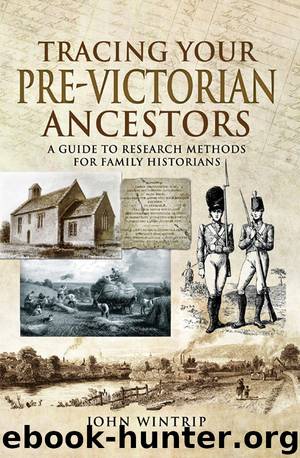Tracing Your Pre-Victorian Ancestors by John Wintrip

Author:John Wintrip
Language: eng
Format: epub
Publisher: Pen and Sword
Published: 2017-03-09T16:00:00+00:00
Chapter 8
SEARCHING FOR INFORMATION
In post-1837 research it is often possible to harvest a significant amount of ‘low-hanging fruit’ using only one online subscription service providing access to only two major genealogical sources: the GRO indexes and the decennial censuses. In contrast, the solution of genealogical problems in the pre-Victorian period frequently requires information from a range of sources, not necessarily available or searchable online. Research on the ancestry of people with certain occupations or who belonged to particular religious denominations may require using very specific sources that researchers have not previously used. Online genealogical search services, whether free or requiring payment, should now be regarded simply as collections of miscellaneous derivative sources. Other relevant sources may only be available in specific archives, or sometimes as microfilm copies available in more than one location.
The first stage in seeking a solution to a genealogical problem in the pre-Victorian period is to identify all the sources in which information could potentially be found and establish how they can be accessed. Selection of relevant sources is dependent what is already known about the family concerned, and should take into account factors discussed in previous chapters, such as social status, religious affiliation and occupation. If a family clearly came from a middle-class background, searching for the wills of family members would be appropriate at an early stage. This requires an understanding of the hierarchy of probate courts in the relevant area, as explained in Raymond (2012) and Gibson and Raymond (2016). If a family is known to have been very poor, searching for relevant Poor Law records would be appropriate. This requires not only an understanding of the operation of the Poor Law, but also an appreciation of any boundary changes that may have affected the current location of records, as explained in Chapter 9.
The process of searching for information can be represented in Figure 1.
Figure 1: Searching for information.
Download
This site does not store any files on its server. We only index and link to content provided by other sites. Please contact the content providers to delete copyright contents if any and email us, we'll remove relevant links or contents immediately.
Twilight of the Idols With the Antichrist and Ecce Homo by Friedrich Nietzsche(17720)
CHERUB: The Recruit by Robert Muchamore(1831)
CHERUB: The Fall by Robert Muchamore(1714)
CHERUB: Man vs Beast by Robert Muchamore(1614)
I Capture the Castle by Dodie Smith(1575)
The Edge of the Abyss (Sequel to The Abyss Surrounds Us)(1470)
Black Genesis by Robert Bauval(1319)
A Brief History of Everyone Who Ever Lived by Adam Rutherford(1250)
all by Unknown Author(1243)
Where Do I Start? by Chase Taylor Hackett(1062)
2016 Baby Names Almanac(980)
Painfully Rich by John Pearson(959)
Genetics by Adam Rutherford(923)
How to Argue With a Racist by Adam Rutherford(883)
2011 Baby Names Almanac(844)
Black Hawk Down by Mark Bowden(829)
It's All Relative by A. J. Jacobs(799)
My European Family by Karin Bojs(787)
Spook Street (Slough House) by Mick Herron(785)
